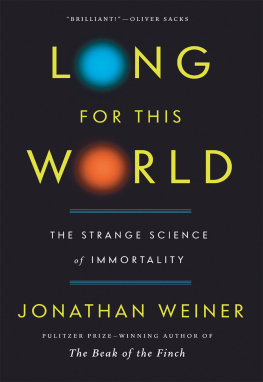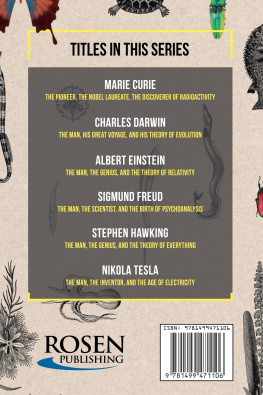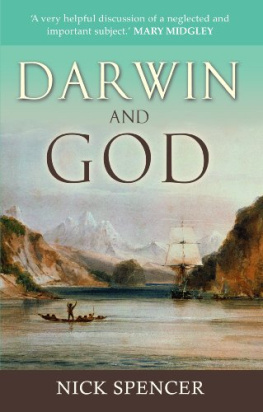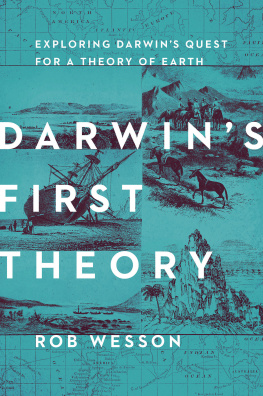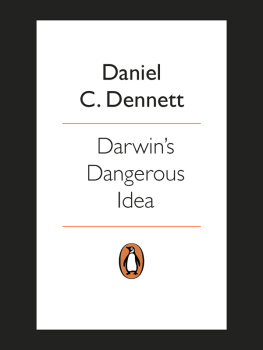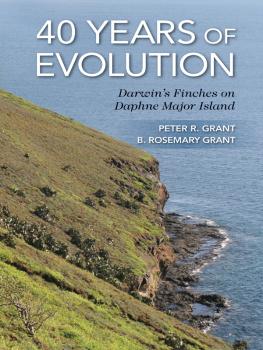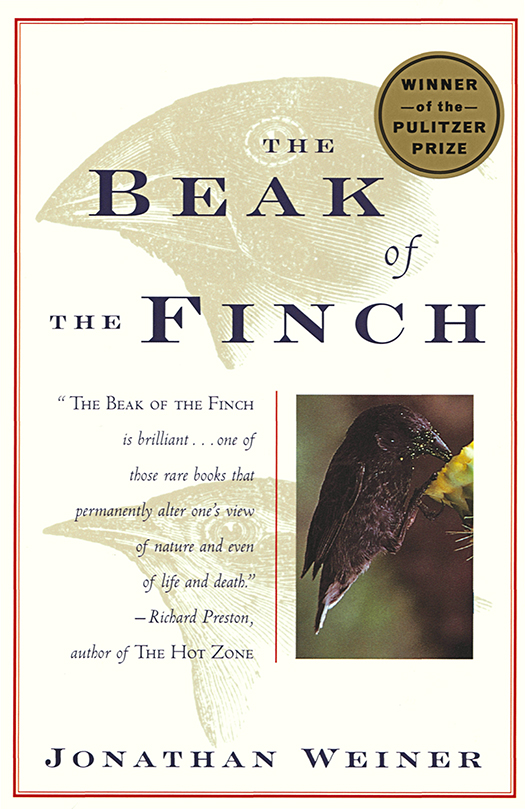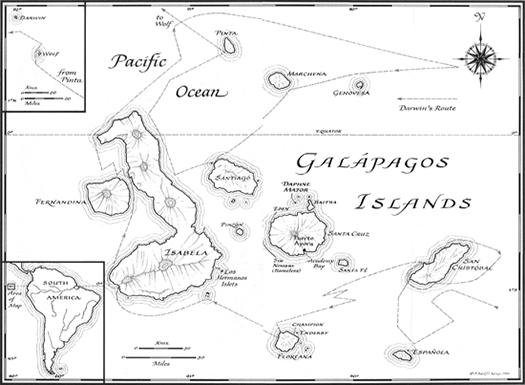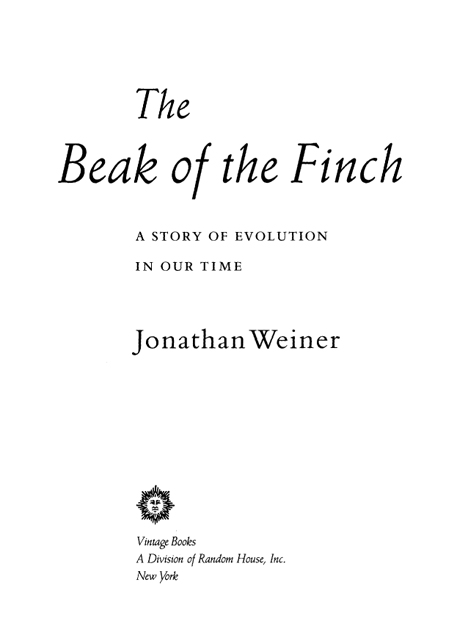Acclaim for Jonathan Weiners
The Beak of the Finch
Admirable and much-needed superb at explaining very complex scientific and philosophical concepts in lucid prose. Weiners triumph is to reveal how evolution and science work, and to let them speak clearly for themselves.
The New York Times Book Review
A sparkling exploration of the single most powerful and compelling force in nature.
Philadelphia Inquirer
This is science writing at its most accomplished: both an account of how science is done and an eloquent illustration of why we do it.
Globe and Mail (Toronto)
Wise and intelligent Weiners engrossing book shows just how profoundly Darwin underestimated the power of his own ideas.
The Sciences
It has every chance of becoming a classic.
The Times (of London)
This is an exceptional book, artfully crafted, lucid and richly descriptive. It is the best exploration of evolution written in recent years. It conveys a powerful insight into life that helps us to understand the fundamental forces of nature and our relationship to the world about us. Highly recommended.
Cleveland Plain Dealer
First class one of the best pieces of science writing that I have read in a long while.
Nature
Spectacular, page-turning the ideal book to recommend to any doubter who asks, wheres the evidence for evolution.
Sunday Times (London)
Jonathan Weiner is a science writer who makes complex research accessible to the ordinary person, and he does so with wit and style. Reads like a combination detective story and adventure book.
Dallas Morning News
Leads us deeper and deeper into what Darwin called the mystery of mysteries. Weiner picks up the pieces of this puzzle and holds them up to the light at just the right angle. He leaves us with not only a greater understanding of the forces of nature but also a greater sense of wonder at creation.
Chicago Tribune
Lyrical as intimate, precise and meticulous as his subjects groundbreaking work, and deserves to have the same wide influence.
The Economist
An invaluable living lesson in evolutionary change.
San Diego Union
This remarkable book will forever change your sense of the pace of natureonce youve read Weiners elegant and absorbing account, the world will seem infinitely more fluid, shifting, alive.
Bill McKibben, author of The End of Nature
Well-written, fascinating this classic of science writing deserves to be as widely read as any Tom Clancy thriller.
Roanoke Times & World-News
Combines vivid and witty on-the-scene reporting with a sound and evocative explication of Charles Darwins place in the history of ideas. Succinct and highly readable, The Beak of the Finch is science writing of a high order.
Timothy Ferris, author of Coming of Age in the Milky Way
Darwins finches make for a scientific thriller in The Beak of the Finch, Jonathan Weiner took me on an astonishing voyage of discovery that, in many ways, is a sequel to the most famous scientific voyage in history.
Rochester Democrat and Chronicle
BOOKS BY JONATHAN WEINER
The Beak of the Finch
The Next One Hundred Years
Planet Earth
FIRST VINTAGE BOOKS EDITION, JUNE 1995
Copyright by 1994 by Jonathan Weiner
Original drawings copyright 1994 by K. Thalia Grant
Map copyright 1994 by Anita Karl and James Kemp
All rights reserved under International and Pan-American Copyright Conventions. Published in the United States by Vintage Books, a division of Random House, Inc., New York, and simultaneously in Canada by Random House of Canada Limited, Toronto. Originally published in hardcover by Alfred A. Knopf, Inc., New York, in 1994.
Grateful acknowledgment is made to the following for permission to reprint previously published material:
Cambridge University Press: Excerpt from Charles Darwins Natural Selection, edited by R. C. Stauffer. Reprinted by permission of Cambridge University Press.
Evolution: Excerpts and two tables from The Hybridization of the Habitat by Edgar Anderson (Evolution 2, 1948, pp. 19). Reprinted by permission of Evolution.
Alfred A. Knopf, Inc., and Faber and Faber Limited: Excerpt from Thirteen Ways of Looking at a Blackbird from Collected Poems by Wallace Stevens, copyright 1923, copyright renewed 1951 by Wallace Stevens. Rights outside the U.S. and Canada administered by Faber and Faber Limited, London. Reprinted by permission of Alfred A. Knopf, Inc., and Faber and Faber Limited.
Science and Robert Holt: Excerpt from Birds Under Selection (review of Evolutionary Dynamics of a Natural Population by B. Rosemary Grant and Peter R. Grant) by Robert Holt (Science, Vol. 249, 1990, pp. 306307), copyright 1990 by the AAAS. Reprinted by permission of Science and the author, Robert Holt.
Darwins route through the Galpagos Islands, in the books map, is redrawn from Frank J. Sulloway, Darwin and the Galpagos, Biological Journal of the Linnaean Society 21 (1984):32.
The Library of Congress has cataloged the Knopf edition as follows:
Weiner, Jonathan.
The beak of the finch: a story of evolution in our time / Jonathan Weiner.1st ed.
p. cm.
Includes bibliographical references (p. ).
ISBN 0-679-40003-6
eBook ISBN 978-1-101-87296-3
1. FinchesGalpagos IslandsEvolution. 2. FinchesEvolutionResearchGalpagos Islands. 3. Grant, Peter R. 4. Grant, B. Rosemary. I. Title.
QL696.P246W45 1994
598.8830438dc20 93-36755
Vintage ISBN: 0-679-73337-X
v3.1
For Deborah
And where is the place of understanding?
It is hid from the eyes of all living;
And concealed from the birds of the air.
Job 28:2021
Preface to the Twentieth Anniversary Edition
Twenty years have passed since The Beak of the Finch was published. Since then, books have been evolving faster than beaks. E-books were still novelties back in 1994.
For this twentieth-anniversary edition, I have decided to keep the text unchanged, except for a few small corrections. I want to let it stand as the portrait of a moment. But the remarkable story of Darwins finches has expanded in significance on every scale, from the smallest to the largest.
On the smallest scale, the story of evolution is written in DNA. Back in 1994, no one could observe Darwins process in Darwins finches from season to season at the molecular level. In The Beak of the Finch, we watch Peter and Rosemary Grant and a few others as they begin to try.
Ten years later, in 2004, a team of researchers led by Cliff Tabin, of Harvard Medical School, working with the Grants, announced the first success of this kind. Tabin and his team identified one of the key genes that sculpts and resculpts the finches beaks under the pressure of natural selection. The gene is called


